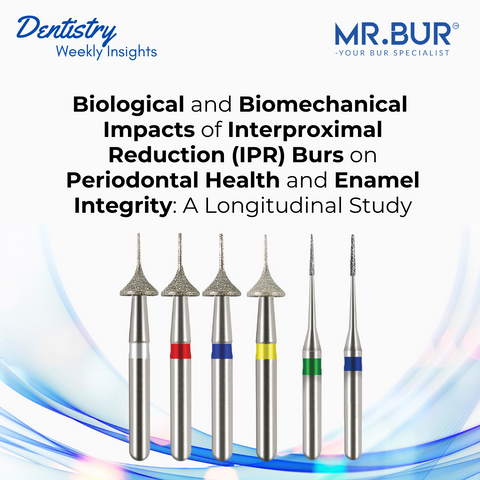In dental restorations, selecting the appropriate carbide bur for each procedure is vital for achieving precision, efficiency, and optimal patient outcomes. Whether it's a filling, inlay or onlay, crown, or implant restoration, using the right bur ensures the treatment is carried out smoothly with minimal discomfort. This article delves into which carbide burs should be used for common dental restorations and provides a detailed breakdown of how these tools are applied at different stages.
Understanding Carbide Burs in Dentistry
Carbide burs are a staple in dental procedures due to their strength, sharpness, and ability to cut through both natural tooth structures and restorative materials like composite, amalgam, or ceramics. Unlike diamond burs, which are abrasive and used for grinding, carbide burs are ideal for cutting and shaping. They also come in various shapes, sizes, and grit levels to suit specific needs.
Key Factors to Consider:
- Shape: The shape of the carbide bur dictates its function. For example, round burs are suited for initial caries removal, while tapered burs are ideal for crown preparations.
- Speed: High-speed carbide burs are used for bulk reduction and cutting, whereas low-speed carbide burs are best for polishing and fine detailing.
Let’s look at the most suitable carbide burs for four major types of restorations: fillings, inlays and onlays, crowns as well as implants.
Carbide Burs for Fillings
A dental filling restores a tooth after removing decay. The filling process requires precise caries removal, cavity shaping, and smoothing for the restoration to adhere properly.
Procedure for Fillings Restoration:
- Initial Examination: The dentist first inspects the tooth visually and through diagnostic tools like X-rays to identify the decayed or damaged area. Local anesthesia is administered to numb the area surrounding the affected tooth, ensuring the patient’s comfort throughout the procedure.
- Decay Removal: Dentist uses a FG Carbide Round Bur with high-speed handpiece to remove the decayed tooth structure. This step involves thoroughly cleaning out the cavity, ensuring all infected tissue is removed.
Mr. Bur Round Carbide Bur (19mm):
Mr. Bur Round Carbide Bur (25mm):
-
Cavity Shaping: Once the decayed material is removed, the cavity is shaped to accommodate the filling material. This involves refining the shape of the tooth using precision Round or Pear-shaped Carbide Bur to ensure proper adhesion of the filling.

-
Filling Placement: The dentist places the chosen filling material (such as composite resin or amalgam) into the prepared cavity. The material is layered incrementally and shaped to restore the natural contour of the tooth
-
Curing: For composite resin fillings, a special curing light is used to harden the material, layer by layer, ensuring a durable restoration.
-
Smoothing and Shaping: After the filling is placed, the dentist uses fine-grit carbide finishing burs such as Egg-Shaped Carbide Bur to smooth and shape the restoration. This step ensures that the filling blends with the natural tooth structure and does not interfere with the patient's bite.

-
Polishing: The filling is polished to create a smooth, glossy surface that resists plaque buildup and matches the appearance of the natural tooth.
-
Bite Check and Adjustment: The dentist checks the patient's bite to ensure proper alignment and makes any necessary adjustments to the filling for optimal comfort and functionality.
Carbide Burs for Inlay and Onlay
Inlay and onlay restorations are dental procedures used to repair teeth that have moderate to severe decay or damage, where a standard filling may not be sufficient but a full crown is unnecessary.
- Inlays: Damage is within the cusps of the tooth.
- Onlays: Cover a large area, extending over one or more of the tooth’s cusps.
Procedure for Inlay and Onlay Restoration:
- Diagnosis and Preparation: Dentists should first evaluate the extent of the damage using clinical exams and imaging. Local anesthesia is administered to numb the area. Once the patient is comfortable, the decayed or damaged portion of the tooth is removed. Using high-speed carbide burs, such as Taper Flat End Carbide Burs or Taper Round End Carbide Burs, to remove the decayed tissue and shape the cavity. These burs ensure precise removal while preserving as much healthy tooth structure as possible.
- Tooth Preparation: After cleaning the cavity, the tooth is prepared for the inlay or onlay. Dentists may use Round Carbide Burs to smooth out the internal walls of the cavity, ensuring a perfect fit for the restoration. The tooth is then carefully measured, and an impression is made, either physically using dental putty or digitally through a CAD/CAM system.
- Fabrication: The inlay or onlay is custom-made in a dental laboratory from materials such as porcelain, composite resin, or gold. For same-day procedures using CAD/CAM technology, the restoration can be milled chairside.
- Placement: Once the inlay or onlay is ready, it is checked for fit and adjusted if necessary. The dentist will ensure that the restoration fits snugly into the prepared tooth and that there are no gaps. A finishing carbide bur, such as a Flame-shaped Carbide Bur, is used to refine the edges and ensure the inlay/onlay is flush with the surrounding tooth structure. The restoration is then cemented into place.
- Final Adjustment: After the inlay or onlay is bonded to the tooth, the dentist will polish it and make final adjustments using fine-grit finishing carbide burs to ensure the restoration aligns perfectly with the patient's bite. Mr. Bur Egg-shaped Finishing Carbide Bur is best for the final adjustment.
Carbide Burs for Crowns
A crown preparation involves reducing the size of the tooth to accommodate the new crown. The procedure demands precision, as too much or too little reduction can affect the fit and function of the crown.
Procedure for Crowns Restoration:
- Initial Assessment & Anesthesia: The dentist evaluates the tooth for any decay or damage and administers local anesthesia to numb the surrounding area, ensuring patient comfort during the crown preparation.
- Tooth Reduction: High-speed carbide burs, such as the Mr. Bur 7404 Egg-Shaped Carbide Bur, are ideal for precise reduction of the lingual fossa in anterior teeth due to their smooth contouring capabilities. For molar tooth reduction, depending on the condition and specific requirements of the patient, a Taper Round End or Taper Flat End Carbide Bur is commonly used. These shapes allow for efficient removal of tooth structure, ensuring accurate reduction while preserving the integrity of the tooth and creating space for a well-fitted crown.
- Marginal Refinement: Mr. Bur Taper Round End Diamond Bur is utilized to create precise margins for the crown. These margins ensure the crown fits snugly around the tooth without any gaps, reducing the risk of bacterial infiltration.
- Impressions: Once the tooth is properly shaped, an impression of the prepared tooth is taken using dental putty or a digital scanner. This impression is used to fabricate a custom crown that fits perfectly over the prepared tooth.
- Temporary Crown: A temporary crown is placed over the tooth to protect it while the permanent crown is being made in a dental laboratory.
- Final Crown Placement: After the permanent crown is fabricated, the dentist removes the temporary crown, cleans the prepared tooth, and cements the new crown in place. Fine adjustments are made using finishing burs to ensure that the crown fits comfortably and functions properly with the opposing teeth.
For a comprehensive breakdown of zirconia crown procedures, including detailed steps and preparation techniques, check out our Zirconia Crowns: Step-by-Step Preparation guide.
Carbide Burs for Implants
Procedure for Implants Restoration:
Dental implants involve placing a titanium post into the jawbone. Bone cutting, shaping, and tooth sectioning may be necessary to create space for the implant.
- Impression Taking: Once the implant has integrated with the bone, the dentist exposes the implant if necessary and takes an impression. While this step doesn’t typically involve burs, some dentists may use a Round Carbide Bur to clear excess tissue around the implant area if necessary before taking the impression.
- Abutment Placement: After the impression, the abutment is placed on the implant. To ensure a smooth and even fit, a Round or Flat-End Taper Carbide Bur may be used to adjust the surrounding soft tissue or refine the fit of the abutment if required.
- Temporary Crown (Optional): If a temporary crown is placed, it may require trimming for proper fit and occlusion. A fine-grit finishing carbide bur, such as Mr. Bur Egg-shaped Carbide Burs Series is ideal for adjusting the temporary crown and ensuring it fits comfortably while the permanent crown is being fabricated.
- Fabrication of the Crown: The dental lab or CAD/CAM system creates the final custom crown using the impression or scan. During this step, the accuracy of the impression or scan will determine the fit of the final crown.
- Crown Placement: The permanent crown is then placed onto the abutment. Adjustments may be needed for proper fit, and this is where carbide burs come into play:
- Taper Round-End Carbide Burs for adjusting the crown’s margins.
- Egg-shaped Carbide Burs Series for final polishing to ensure smooth transitions and proper occlusion.
- Final Adjustment and Polishing: After placement, the crown may require further adjustments to ensure a perfect fit. The dentist will use Egg-shaped Carbide Bur to refine the occlusion and polish the surface, making sure the crown blends seamlessly with the patient's natural teeth.
Conclusion: Choosing the Right Carbide Burs for Dental Restorations
Selecting the correct carbide burs is critical for achieving optimal outcomes in dental restorations. Each procedure—whether it's a filling, onlay, crown, or implant—requires specific bur shapes and grit sizes to cut, shape, and refine the tooth or bone accurately. By using the appropriate burs for each step, dentists can ensure smoother procedures, better patient comfort, and long-lasting restorations.
Evaluate the needs of each restoration carefully, and ensure you’re equipped with the right burs to meet the demands of modern dental practice.
MR. BUR US we provide a wide range of dental burs selection in global.
Diamond Burs, Carbide Burs, Surgical & Lab Use Burs, Endodontic burs, IPR Kit, Crown Cutting Kit, Gingivectomy Kit, Root Planning Kit, Composite Polishers, High Speed Burs, Low Speed Burs
Subscribe our newsletter now!












